- Retour accueil
- Vous êtes ici : Blog The Pyramids of the Cold The Pyramids of the Cold Section 17 • the Ankh symbol and the changes made by Akhenaten and Nefertiti
The Pyramids of the Cold Section 17 • the Ankh symbol and the changes made by Akhenaten and Nefertiti
Publié par Bruno Coursol dans The Pyramids of the Cold le 12/04/2022 à 20:00
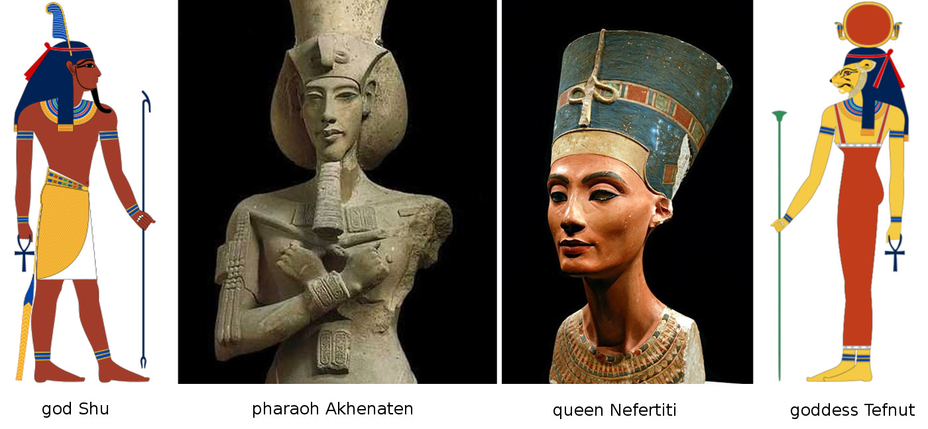
Drawing of Shu by Jeff Dahl : https://en.wikipedia.org/wiki/Shu_(Egyptian_god)#/media/File:Shu_with_feather.svg
King Akhenaten from tutincommon on flickr and bust of Queen Nefertiti from the Ägyptisches Museum Berlin collection, presently in the Neues Museum and photographed by Philip Pikart : https://en.wikipedia.org/wiki/Nefertiti#/media/File:Nofretete_Neues_Museum.jpg
Drawing of Tefnut by A8takashi : https://en.wikipedia.org/wiki/Tefnut#/media/File:Tefnut.png
The Pyramids of the Cold - Section 17 • The changes made by Akhenaten and Nefertiti
In summary : King Akhenaten and his wife Nefertiti represented themselves as god Shu and goddess Tefnut, the deities that combined together created the evaporative cooling in the Great Pyramid of Giza. In other words, Akhenaten and Nefertiti wanted to be seen as the ones creating the magical cold, and that is what they are giving to the heat of the solar rays : the ankh symbol is a representation of the evaporative cold.
Akhenaten and Nefertiti stopped worshiping Amun, the deity that was directly referring to the evaporative cold produced inside the Great Pyramid of Giza, but they kept worshiping the evaporative cold, from the theoretical point of view. This could be the first recorded fracture between theoretical and experimental science.
17.01 Akhenaten the heretic king
King Akhenaten was an ancient Egyptian pharaoh of the Eighteenth Dynasty who abandoned Egypt's traditional polytheism for Atenism, a worship centered around one single god : Aten. But at the same time, Akhenaten represented himself as god Shu, and his wife Nefertiti as the ancient Egyptian goddess Tefnut. After Akhenaten's death, his son Tutankhamen restored the ancient traditional polytheism.
Akhenaten 's name meaning was "Effective for the Aten". Reigning about 17 years, between 1353 and 1336 BCE, or between 1351 and 1334 BCE, he was the tenth ruler of Dynasty 18. Before the fifth year of his reign, he was known as Amenhotep IV (Ancient Egyptian: jmn-ḥtp, meaning "Amun is satisfied").
King Akhenaten from tutincommon on flickr and bust of Queen Nefertiti from the Ägyptisches Museum Berlin collection, presently in the Neues Museum and photographed by Philip Pikart : https://en.wikipedia.org/wiki/Nefertiti#/media/File:Nofretete_Neues_Museum.jpg
Drawing of Shu by Jeff Dahl : https://en.wikipedia.org/wiki/Shu_(Egyptian_god)#/media/File:Shu_with_feather.svg
Drawing of Tefnut by A8takashi : https://en.wikipedia.org/wiki/Tefnut#/media/File:Tefnut.png
17.02 The misleading theory of the monotheism of Akhenaten's religious changes
If most people know that Akhenaten pretty much wiped out every single god of his ancestors, few probably know that Akhenaten represented himself as god Shu and his wife Nefertiti as goddess Tefnut.
It looks like all the attention on the changes made by Akhenaten on the Egyptian religion, was directed towards Aten, the Solar disc god ; but I think we got mislead : what we should have focus ourselves on, was Shu and Tefnut.
I understand that egyptologists didn't want to talk about anything else than Aten, because if they would have try to explain why a pharaoh and his wife were depicting themselves as gods, they would probably have to rethink everything about ancient Egyptian religion.
Representing ourselves as god is a pretty strong statement, don't you think? Some could even say it is a huge political statement.
To this day, both the French and English Wikipedia's pages about Akhenaten don't even mention that fact*. The least we can do is talk about it.
Additionally to Shu and Tefnut, Akhenaten also liked to represent the Ankh sign, a symbol I just couldn't figure out exactly until I started to work on this heretic king.
Shu, Tefnut and the Ankh symbol are linked together, and I will try to demonstrate in this article that it is Akhenaten and Nefertiti who are giving the Ankh symbols to the Aten solar disc, and not them who are receiving the Ankhs ; and that the meaning of this Ankh symbol isn't "life" or "breath of life", but "cold air".
*In the entire English Wikipedia's page on Akhenaten (a document of about 10575 words, according to http://compteur-de-mots.net/), the word "Shu" appears 2 times, but only in a discussion about Aten's name ; and the total amount of times that "Tefnut" is written in the page about Nefertiti… is zero (copy-paste the text in Word and use the Research function, for example).
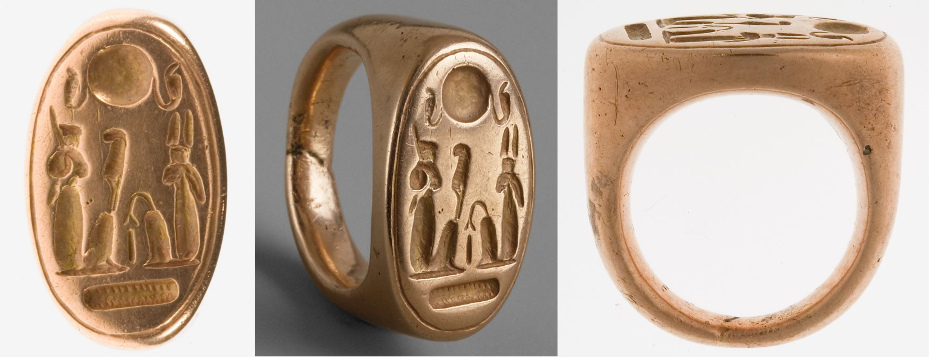
Finger Ring depicting King Akhenaten and Queen Nefertiti as Shu and Tefnut from the Metropolitan Museum of Art. New Kingdom, Amarna Period, ca. 1353–1336 BC. Accession Number : 26.7.767. https://www.metmuseum.org/art/collection/search/544679
Excerpt from the MET data sheet : "This ring was found at Amarna. The hieroglyphs may be read as an ideogram. The two seated figures are probably Akhenaten (left) and Nefertiti (right) as the deities Shu (air as indicated by the feather he holds) and Tefnut (moisture)".
17.03 Akhenaten represented himself as god Shu and Nefertiti as goddess Tefnut
It is often said that Akhenaten rejected every ancient Egyptian god and that the cult of Aten was monotheist, but it isn't exact : Shu and Tefnut were saved.
Not only Shu and Tefnut were the only deities that Akhenaten didn't reject when he decided to reject all the other ancient deities, but surprisingly he decided that he would himself be depicted as god Shu, and his wife Nefertiti as the goddess Tefnut.
"During the “Aten heresy” led by Akhenaten, Shu, and Tefnut remained popular with the apparently monotheistic pharaoh. The pharaoh and his queen (Nefertiti) were depicted as the personification of Shu and Tefnut emphasising their divinity. As the Aten represented the sun disk, the solar aspect of Shu and his link with the pharaoh apparently prevented Shu from being proscribed along with Amun and the other gods." https://ancientegyptonline.co.uk/shu/
"Even on the pharaoh's own stone sarcophagus, images of Nefertiti replaced those of traditional goddesses. Akhenaten, by associating himself with Shu and the Aten, and Nefertiti with Tefnut, had effectively presented himself and his family as living gods." https://www.worldhistory.org/article/1110/the-art-of-the-amarna-period/
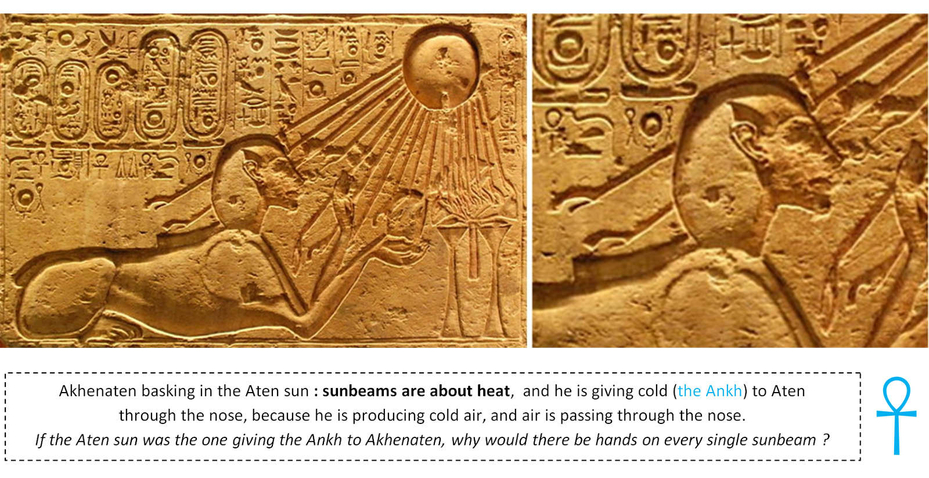
King Akhenaten worshiping Aten. Please notice the Ankh sign pointed towards the nose of Akhenaten as a sphinx. Source : Echnaton (Akhenaten) as Sphinx. From Amarna. Kestner Museum, Hannover. Photographed by Hans Ollermann on flickr : https://www.flickr.com/photos/menesje/2212492438/
17.04 The Akhenaten sphinx basking in the Aten Sun : beams are about heat, not light
This image showing King Akhenaten in the form of a sphinx is maybe one of the best representations of the real meaning of the sun Aten.
It is said that Aten is radiating beams of light, but the position of the sphinx is telling us another story : he is depicted resting on the ground with the sun beams all around him, back included, and these beams have hands at their ends.
Hands are made for touching, so the solar beams are "touching" the sphinx but also all the scenery around him : they are not light beams but they are transmitting the heat radiating from the Solar disc Aten and they are "petting" the sphinx who is basking in the sun.
"Shu is thus not only "air which is in the sun", but also, according to Akhenaton's religion, "heat which is in Aton". Egyptian Myths And Legend, By Donald Mackenzie
Aten is a representation of the heat, and in my opinion it is just here to emphasize Akhenaten's role/performance/demonstration into cold production.
Aten is not shown with beams of light emanating from him : he is radiating heat.
If Akhenaten is receiving the Ankh symbols of life from Aten because of the hands at the end of the Solar beams, why is there also hands on every single beam, whether they are directed towards Akhenaten/Nefertiti or not ?
Hands are not giving the Ankh symbols, they are taking them from Akhenaten and Nefertiti.
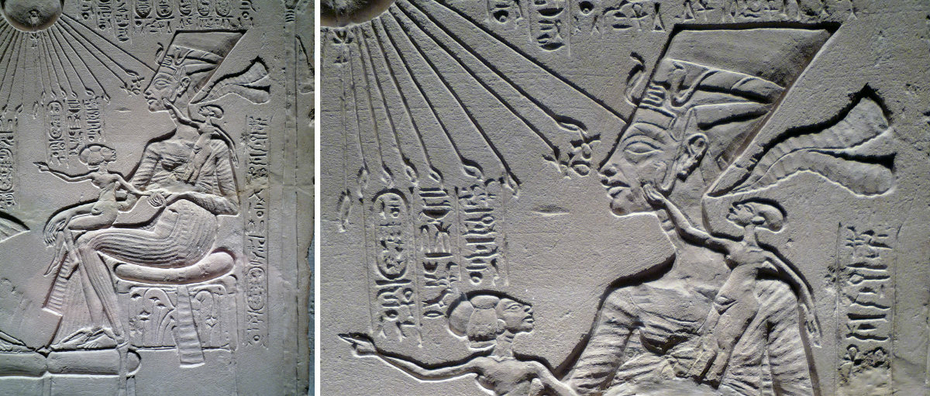
Detail (showing Akhenaten) of the relief of King Akhenaten (Akhenaton) and Queen Nefertiti, in the State Museums at Berlin : King Akhenaton (left) with his wife, Queen Nefertiti, and three of their daughters under the rays of the sun god Aton, altar relief, mid-14th century BCE. Photographed by Steven Zucker and posted on flickr, https://www.flickr.com/photos/profzucker/7670416780/in/photostream/
17.05 King Akhenaten and Nefertiti were creating cold air : that is the meaning of the Ankh symbol
If it is Akhenaten/Shu (meaning the dry warm air) and Nefertiti/Tefnut (meaning the spat water in the form of droplets) who are giving the Ankh symbols to the Solar disc Aten, then it means that the Ankh symbol is what comes out of the association of Shu and Tefnut : cold air.
The Ankh is the symbol of cold air, an element that is processed through the nose and that explains why Akhenaten and Nefertiti are expelling Ankh symbols through the nose : they are expelling cold air through the nose.
The hands at the end of the Solar beams are not meant to grab something (exception made of the Ankhs generated by Akhenaten and Nefertiti), they are here to emphasize the fact that these beams were touching things and people. The beams are representing the heat of the Solar disc Aten, and only Akhenaten and Nefertiti themselves would be able to respond to it, with the cold air : the Ankh symbols.
17.06 The Ankh is the symbol of the evaporative cooling
Akhenaten and his wife Nefertiti represented themselves as god Shu and goddess Tefnut, the deities that combined together created the evaporative cooling in the Great Pyramid of Khufu.
In other words, Akhenaten and Nefertiti wanted to be seen as the ones creating the magical cold, and that is what they are giving to the heat of the solar rays : the ankh symbol is the cold.
Please note on this State Museums at Berlin's relief, that both Akhenaten (above photograph) and Nefertiti (photograph below) have Ankh signs next to their noses. These Ankhs aren't given to them by Aten, but it is they, Akhenaten and Nefertiti who are giving the Ankh symbols : they are offering the cold.
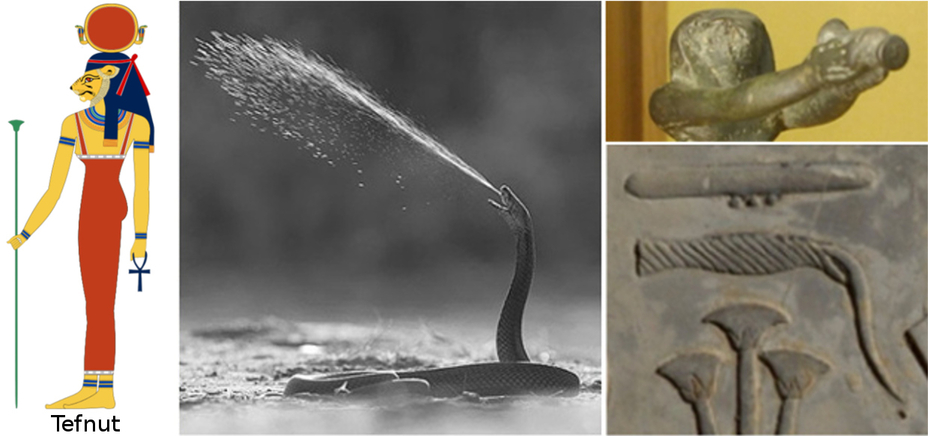
It is the association of dry warm air (personified as god Shu) and spat water (the goddess Tefnut), that was producing the cold in the horizontal passage of the Great Pyramid, by evaporative cooling.
17.07 Goddess Tefnut isn't a representation of any kind of water : she stands for spat water, that is water in form of liquid droplets
Tefnut isn't a representation of any kind of water : it is not about the water from the Nile (that is represented with god Hapi), or water from the ocean or water to drink : Tefnut is representing spat water, that is water in form of liquid droplets, whether it is dew drops, or rain drops or even tinier drops that are responsible for moisture and humid air.
This water spitting thing is so important that this is even represented in her name.
"Tefnut (tfnwt) is a deity of moisture, moist air, dew and rain in Ancient Egyptian religion."
"Literally translating as "That Water", the name Tefnut has been linked to the verb 'tfn' meaning 'to spit' and versions of the creation myth say that Ra (or Atum) spat her out and her name was written as a mouth spitting in late texts." https://en.wikipedia.org/wiki/Tefnut
17.08 God Shu isn't a representation of any kind of air : he stands for dry and warm air but also fog
"The ancient Egyptian god Shu is represented as a human with feathers on his head, as he is associated with dry and warm air." [...]
"Fog and clouds were also Shu's elements" https://en.wikipedia.org/wiki/Shu_(Egyptian_god)
"Shu is thus not only "air which is in the sun", but also, according to Akhenaton's religion, "heat which is in Aton". Egyptian Myths And Legend, By Donald Mackenzie
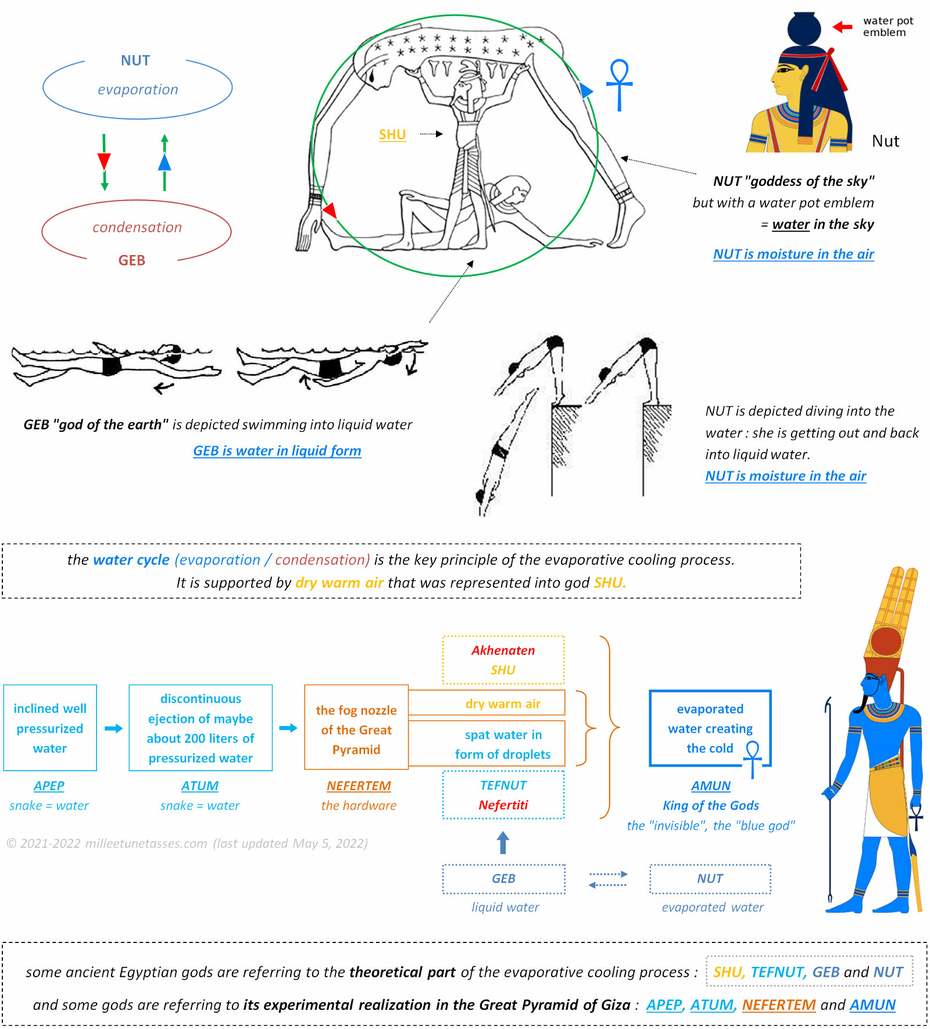
17.09 Theoretical physics (SHU and TEFNUT) versus experimental physics (AMUN)
I couldn't find any reference to the roles that took Shu and Tefnut under the reign of Amenhotep III, but it is well documented that his son Amenhotep IV (Akhenaten) represented himself in Shu (the god of dry and warm air), while his wife Nefertiti represented herself in Tefnut (the goddess of spat water). We've also seen that this is Akhenaten who is giving the Ankh symbol to the heat of Aten.
And this is the key to understand what happened with Akhenaten heretic vision of religion.
We've seen that worshiping Amun or the Aten, at the time of Amenhotep III was considered to be the same thing. It was 2 different point of views of the same thing, 2 visions of the evaporative cooling process : the theoretical point of view and the experimental point of view.
For hundreds of years, what had been worshiped the most was what happened in the Great Pyramid : Apep (the pressurized waters of the well), Atum (the small amount of pressurized water ejected out of the well at each cycle of operating of the impactor), Nefertem (the pipe and the fog nozzle) and Amun (the fog of microdroplets evaporating and creating the cold), are all directly referring to the Great Pyramid.
Shu (the god of dry and warm air), Tefnut (the goddess of spat water), Geb (the god of liquid water) and Nut (the goddess of humidity, water in the air), are all about the theoretical point of view of the evaporative process.
For some reason, what Amenhotep III and IV (Akhenaten) wanted to do, is to focus their worshiping to the theoretical vision of the evaporative process, to the detriment of the historical experimental accomplishments in the Great Pyramid.
"Theoretical physics is a branch of physics that employs mathematical models and abstractions of physical objects and systems to rationalize, explain and predict natural phenomena. This is in contrast to experimental physics, which uses experimental tools to probe these phenomena." Source Wikipedia
17.10 Akhenaten rejected everything about HOW was produced the cold, and HOW it will be used
It is like Akhenaten decided to forget and disprove every part of ancient religion that referred to how was created the cold : all the gods referring to the Grand Gallery (like Ptah, Sokar, Osiris, Aker...) or the Great Serpent Apep of the inclined well or even Nefertem and its fog nozzle in the horizontal passage. But he also wasn't interested in how it will be used in the Solvay process cooling (Horus, Isis, Nephthys, Seth...).
In other words, Akhenaten wanted to concentrate its worship on the central part of his ancestors work, the magical part of the entire Solvay manufacturing : the cold and the chemical manufactured products of the Solvay process itself.
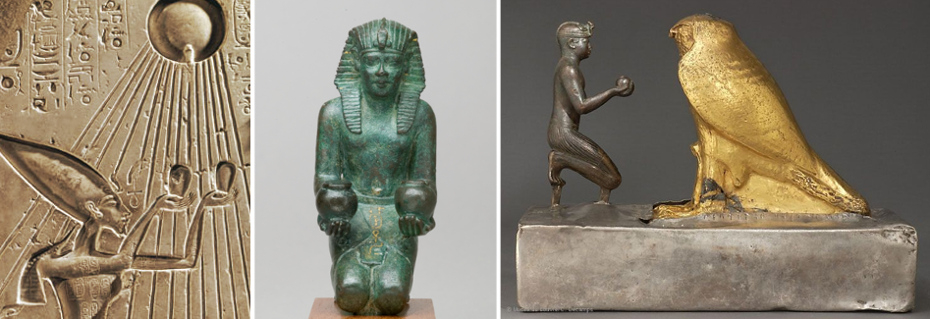
Kneeling statuette of King Amasis, from the Metropolitan Museum of Art, New-York. Accession Number: 35.9.3 ; 570–526 B.C. (center image).
Pharaoh king Taharqa "presenting god Hemen with wine" E25276 from the Louvre Museum, Paris (right image).
This amazing artifact from the Louvre Museum is outstanding, because it shows a pharaoh kneeled down in front of the representations of the heat generated by the chemical manufacturing (the falcon) and the cold production (the snake), both put on the representation of the impactor of the grand gallery / inclined well : the wooden hollow base of the figure.
17.11 Akhenaten only changed the rules, not the game
"During the Amarna Period (1353 - 1336 BCE), when Akhenaten banned the cult of Amun along with the rest of the gods and raised the god Aten as the sole god of Egypt, the ankh sign continued in popular use. The symbol is seen in paintings and inscriptions at the end of the beams of light emanating from the solar disc of Aten, bringing life to those who believe." https://www.worldhistory.org/Ankh/
This excerpt from worldhistory.com is particularly interesting : the academic interpretation is that the ankh sign is given by Aten to Akhenaten and Nefertiti.
But I disagree. In my opinion, this scene has to be interpreted in the exact same way as the one with pharaoh Amasis and his two jars, on the above photograph.
King Amasis was following the tradition : he was worshiping the entire story of his ancestors and he was demonstrating that the chemical manufacturing of sodium carbonate and sodium bicarbonate by the Solvay process was successful.
King Akhenaten doesn't want to continue worshiping non important gods, he doesn't care about the technical part of the process, he just cares about the cold and he wants to be associated with it.
The cold is the only thing you need to complete the Solvay process.
The evaporative cooling is the transformation of dry warm air into cold air, using water in form of droplets, but the key is air. The cooling is producing cold air. And air is processed through the nose.
Akhenaten not only wanted to show that he was successfully able to manufacture the Solvay products, but he also wanted to demonstrate that he was creating the cold.
King Akhenaten is represented giving the 2 jars containing sodium carbonate and sodium bicarbonate to the Aten Solar disc, but he is also represented breathing cold air.
17.12 The meaning of Akhenaten's name is "Effective for the Aten" : it suggests that he was supposed to produce something
The idea that Akhenaten is depicted giving something to Aten, instead of the opposite, is actually suggested in his name : the meaning of Akhenaten is "Effective for the Aten". And that was also true for the first 5 years of his reign when his name was Amenhotep IV, from the ancient Egyptian: jmn-ḥtp, meaning "Amun is satisfied".
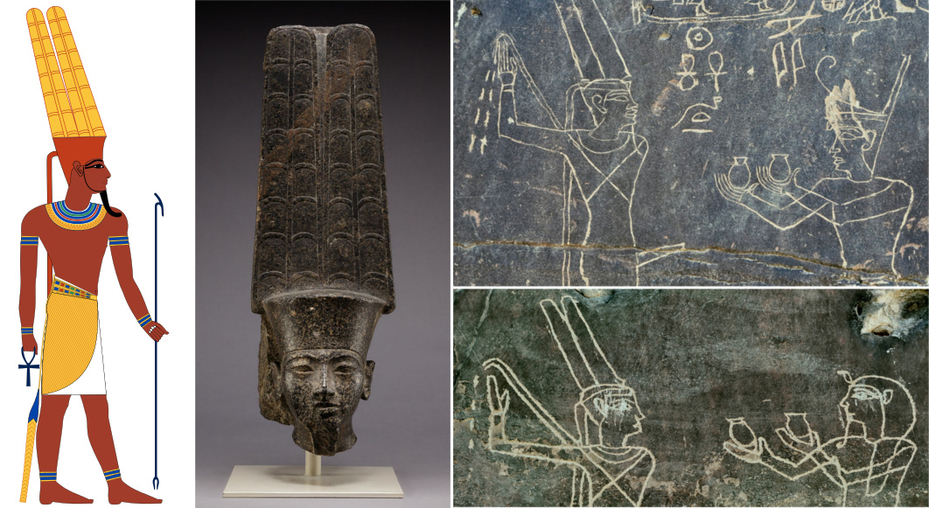
Representations of ancient Egyptian god Amun. Draw courtesy of Jeff Dahl : https://en.wikipedia.org/wiki/Amun#/media/File:Amun.svg
Head of Amun from the Metropolitan Museum of Art : https://www.metmuseum.org/art/collection/search/544780
17.13 Aten "simply became another way in which to express one's devotion to Amun" : devotion to Aten = devotion to Amun
About Amun : "His cult was the most powerful and popular in Egypt for centuries", but Amenhotep III and his son Akhenaten wanted to banish Amun and replace him with Aten : this is not Akhenaten (Amenhotep IV) who introduced the cult to Aten, but his father Amenhotep III, and the Aten was also directly referring to the cult of Amun.
"By the time of Amenhotep III (1386-1353 BCE), the priests owned more land, had more cash on hand, and were almost as powerful as the pharaoh. Amenhotep III introduced religious reforms in an attempt to curb the power of the priesthood, but they were fairly ineffective.
His most significant reform was the elevation of a formerly minor deity, Aten, to his personal patron and encouraged the worship of this god alongside Amun. The cult of Amun was unaffected by this, however, and continued to grow. Aten was already associated with Amun and with Ra as the solar disc representative of the sun's divine power. The symbol of Aten simply became another way in which to express one's devotion to Amun, and the priests continued to live their comfortable lives of privilege and power." https://www.worldhistory.org/amun/
In summary : the devotion to Aten = devotion to Amun.
17.14 Amun is the personification of the Dendera Light fog of microdroplets creating the evaporative cold
If, in some ways, Amun = Aten, and Aten is all about the evaporating cooling because of Shu and Tefnut, then it means that Amun is also about the evaporative cooling.
"Amun (also Amon, Ammon, Amen, Amun-Ra) is the ancient Egyptian god of the sun and air. He is one of the most important gods of ancient Egypt who rose to prominence at Thebes at the beginning of the period of the New Kingdom (c. 1570-1069 BCE). His cult was the most powerful and popular in Egypt for centuries."
"He was known as "The Concealed God" - he whose nature could not be known and associated with air or the wind which can be felt but not seen or touched."
"His name means "the hidden one," "invisible," "mysterious of form"… His presence was everywhere, unseen but felt like the wind."
https://www.worldhistory.org/amun/
All these epithets of Amun are strongly suggesting that he was the representation of the fog of microdroplets that was created into the horizontal cooling passage of the Great Pyramid : it was becoming humidity, water in the form of a gas, hence invisible, with no shape and it was engulfing into the passage with the speed of the wind.
In other words, Amun is the personification of the Dendera Light.
The idea of Amun being a metaphoric personification of the Dendera Light / fog of microdroplets evaporating and creating the cold, is reinforced by the similarities between Amun and Aten, the god worshiped by Amenhotep III and his son, Akhenaten.

Diagram of the Great Pyramid of Giza in operation, before the shutdown procedure and the draining of the inclined well.
17.15 Summary of the study : hidden behind the academic vision of the ancient Egyptian religion, a vast number of metaphors are describing some of the most advanced science and technological knowledge of that time : ancient Egyptian gods were nothing else than pharaohs' metaphoric self-glorifications of their theoretical and experimental scientific accomplishments in physics and chemistry.
Pharaohs used the power of Science to legitimate themselves as kings of Egypt : they forged an entire religion, based on science to rule their kingdom, and they presented that science as Magic.
The end game of this technological program that probably started on the very first Dynasty, was the Great Pyramid of Giza where evaporative cooling was engineered in the known part of the pyramid from the pressurized water produced in the inclined well, known today as the ascending passage.
The evaporative cold simply took advantage of the power of water, and was most probably necessary to cool down chemical manufacturing of sodium carbonate and sodium bicarbonate produced by an ammonia-soda Solvay process, as suggested by the very strong ammonia smell and the limestone kiln in the so-called burial chamber of the Red Pyramid. At that time, sodium carbonate was called natron, and it was the salt used for the mummification of the pharaohs (Sections 14, 15 and 16).
The cooling seems to have represented the most difficult part of the process, as suggested by the Step Pyramid's official name : according to scholars, the very first pyramid complex, the Step Pyramid of Djoser, was called "the refreshment of the Gods". No doubt that a more accurate translation would certainly be "the cooling of the Gods".
It means that ancient Egyptians were the first civilization to master a Solvay-like process for sodium carbonate manufacturing, long before it got reinvented in the 1800's in Europe. The key elements of that process is the temperature control of the chemical reactions (the cooling), and the dome shaped plate necessary for the counterflow chemical reactions to occur in an efficient way. That counterflow reaction plate is what really is the disc of Sabu.
As shown with Akhenaten and Nefertiti, the creation of the evaporative cold was the most sacred accomplishment of all (Section 17), and this is exactly what the Dendera Light is all about : the Dendera Light is the fog of microdroplets of liquid water that evaporates and creates the cold. Talking about the snake inside the Dendera Light Bulb : "The field surrounding Ra’s snake form is referred to in ancient Egyptian literature as protective magical energy in liquid form that all gods and pharaohs possess" (Faulkner, Section 2).
Everything that had been done in the Great Pyramid of Giza inspired most of the ancient Egyptian religion, and it had been glorified into what we know today as the Underworld.
The Underworld is referring to the chambers and passages of the Great Pyramid of Khufu, and in particular to the Grand Gallery where a hauling gantry beetle operated a wooden coffin shaped impactor that had a small nested granite block inside it. The impactor generated endlessly, over and over, maybe every 15 minutes the pressurized water that was then transformed into a fog of microdroplets inside the horizontal cooling passage.
The Grand Gallery of the Great Pyramid where the act of hauling was done, is the "Secret Hauling Cavern of the Underworld" described in the Amduat "Book of the Hidden Chamber".
The most important chamber of the Great Pyramid wasn't the King's chamber that only was the main water tank of the pyramid, but the Queen's chamber, the only one on the central axis of the pyramid. Because the Queen's chamber was inaccessible from the rest of the pyramid, it was glorified into the "Hidden Chamber of the Underworld" (Section 11), and because the Queen's chamber was the coolest place in the pyramid (about 5°C / 41°F), and with a constant 100% Humidity rate, this chamber was the one where the biggest amount of very hard salt encrustation had been documented by the first explorers of the pyramid in the 1800's and before it had been removed in 1998 by Zahi Hawass (Section 1). Very hard salt encrustation is the signature of the evaporative cooling process, even nowadays.
The most incredible thing is that pretty much everything I've just said, actually appears in one single myth, but it doesn't originate from ancient Egypt : it is the "Churning of the Ocean" Hindu myth that produces the immortal nectar Amrita. The fact is that the endless churning of water that ends up with the production of an elixir that gives eternal life, is exactly what were doing ancient Egyptians in the inclined well : natron was the salt used for the mummification of pharaohs.
Natron gave eternal life to pharaohs, just like the Amrita (Section 19).
Poster un commentaire

